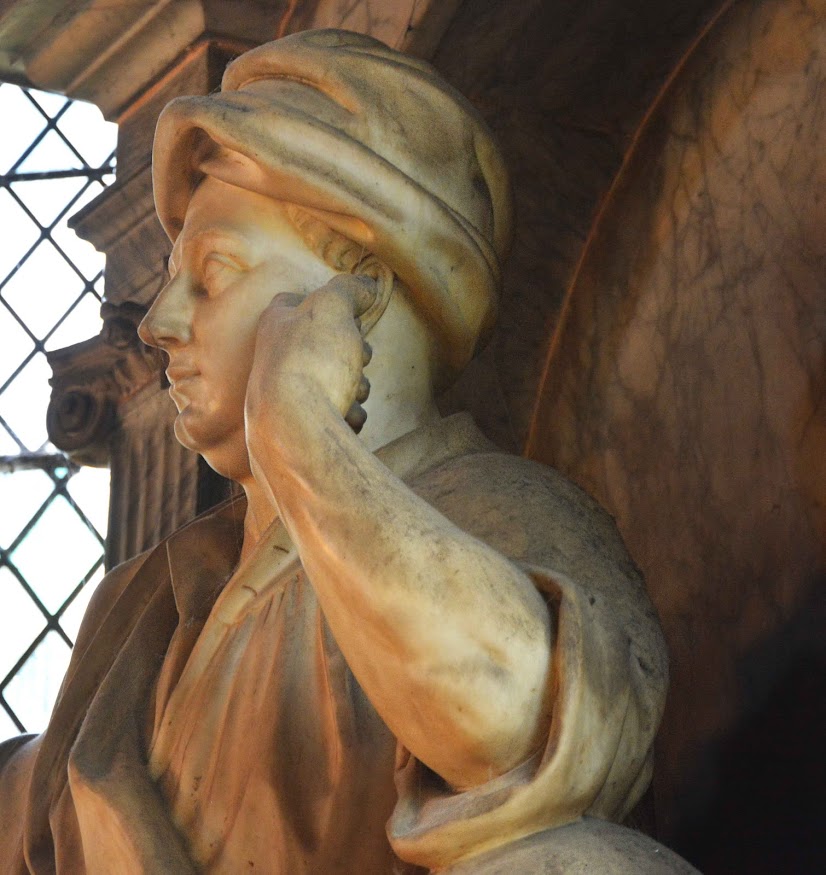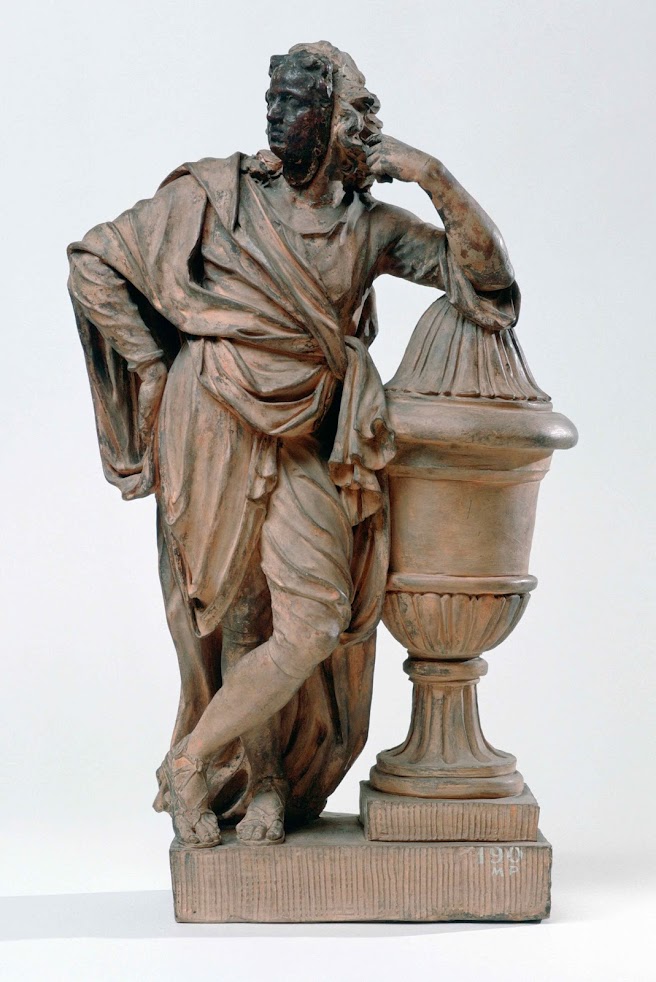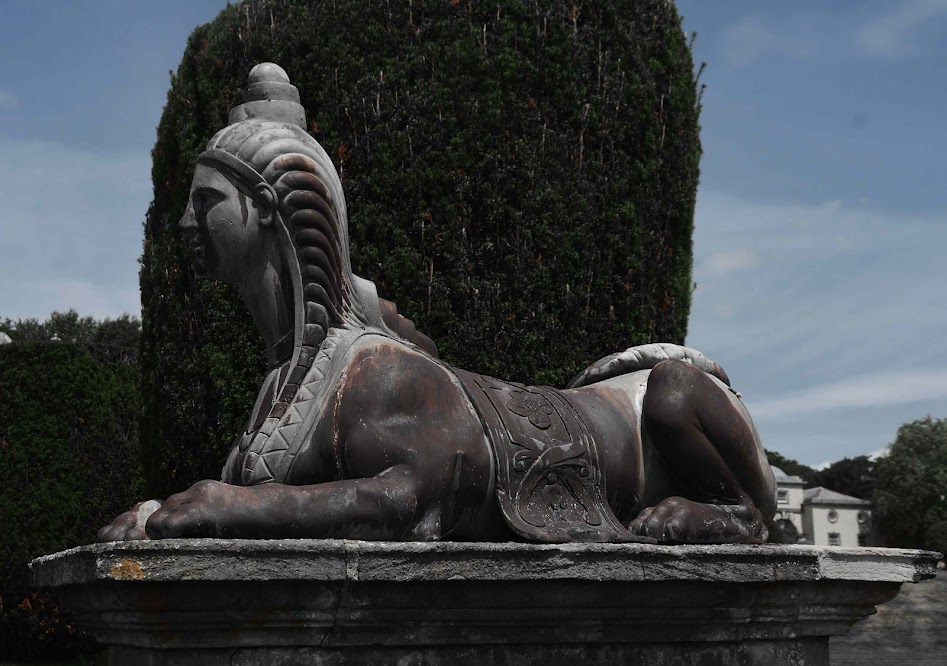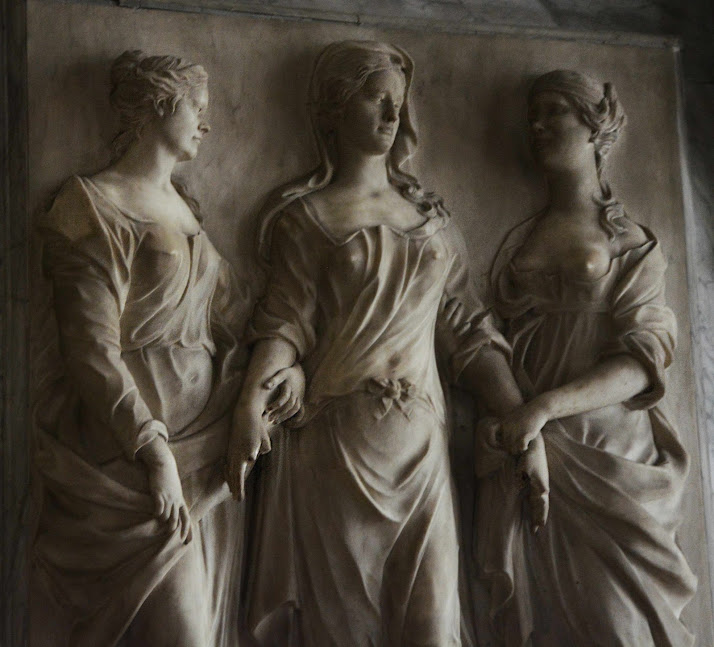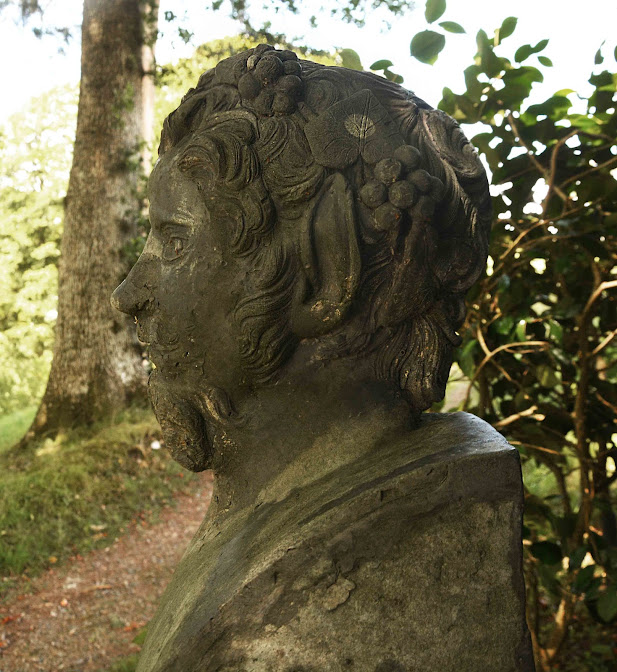Another work in progress.
The Two Statues of Aeneas and Anchises and Hercules and Cacus.
Attributed to Andreas Kearne (Kearn or Karn?).
Glendon Hall. Northamptonshire.
Originally at Boughton, Northamptonshire.
A good reason for posting here is so that there is no confusion with other versions of these statues.
Glendon Hall has now been divided into four apartments.
I believe that the statues are still in situ, but in a property now adjoining Glendon.
.....................
Andrew Kearne, seems likely to have been the sculptor at Lamport, Northamptonshire. He
is known to have been working at Lamport when a chimneypiece was carved, with
Vertue recording that he “carv’d many Statues for Sr Justinian Isum” at Lamport.
George Vertue, MS 23.069, in “Vertue I”, 98. He is further recorded
as being a competent sculptor in stone, and brother-in-law to Nicholas Stone.
He created the
lioness for the York Watergate (see below), and also a chimneypiece for Castle Ashby, not far from Lamport. Mark
Girouard, A Biographical Dictionary of English Architecture 1540 – 1640, (London: Paul Mellon
Centre for Studies in British Art, 2021), 188, 285.
See also BDS, 683; Spiers, “Nicholas Stone”,
Kearne married the sister of Nicholas Stone (1586 - 1647).
Stones workshop was on the South side of Long Acre at the St Martin's Lane end.
for Stone Notebook and Account Book see - https://www.walpolesociety.org.uk/vol7
extracts below.
Page 31 -
We know that Stone had a sister, who married Andrew Kearne,
a German sculptor, who assisted him in his work, and of whom mention is made
later. In the cancelled portion of his will Stone left ' unto Grace the nowe
wife of Andrewe Kerne and all her children tenn pounds vizt. five pounds to
herself and the other five pounds amongst her children. The expression 'nowe
wife' is ambiguous ; he does not call her his sister, and yet if she was a
second wife it is difficult to understand why this ten pounds should have been
left to her and her children.
Page 34
Nothing appears to be known of any original work of the
various craftsmen employed by Stone with the exception of that of Schoerman and
Kearne, a fact which suggests that it may have been only of value when under
the supervision of a master mind ; of these two, however, Vertue has been able
to give some information.
1 John Schoerman was born at Embden in the Low
Countries; he executed for Sir John Danvers, of Chelsea, two sitting figures of
shepherds and a group of Hercules and Antaeus, for which he received
respectively £6 and £16, and an effigy of Sir Thomas Lucy for his monument in
Charlcote Church, at a cost of £20 los. ; and another of Lord Belhaven at
Holyrood, at a cost of £18; he also did some work for Sir Simon Baskerville.
Andreas Kearne was a German who married Nicholas Stone's sister. He carved some
statuary for Sir Justinian Isham, of Lamport, Northants, and statues of Apollo
and Venus for the Countess of Mulgrave. These, for which he obtained £7 apiece,
were six feet in height and were of Portland stone.
info above from -
......................
Aeneas and Anchises.
The Statue is perhaps loosely based on an engraving by Agostino Cerracci after Barocci (1595).
or less likely Gerard Audran (1640 - 1703), both engravings depict a bearded Aeneas wearing an helmet
But the face of Aeneas possibly represents Charles I - the bronze bust at Stourhead by Hubert Le Seuer has similar features.
It is not clear what materials are used here Kearne is known to have worked in lead and stone.
Image below from Country Life, November 1922.
A similar stone plinth without the decoration exists at Boughton.
.............
The Stourhead bust of Charles I.
Hubert le Sueur (c.1580 - 1658).
of Tangential Interest -
There is a lead bust at Castle Hill, Devon perhaps related that has similar features but represents Pan.
It has been much distressed and the head appears to have been grafted onto the herm type bust.
I will be posting on the statuary at Castle Hill in due course.
...................................
I have lifted the text below from Northamptonshire Past and Present. 1977.
https://www.northamptonshirerecordsociety.org.uk/pdf/npp/volume-5/npp-v5-n5.pdf
The Development of Tudor and Stuart Garden Design in
Northamptonshire.
J. M. Steane
Boughton. (SP896814) This is probably the finest formal
garden layout in England. The original scheme was carried out by Ralph Montagu, the first
Duke, between 1684 and 1709 and then it was modified and extended by his son, John, second
Duke, appropriately called "the Planter" in the 1720s, 30s and 40s.
It had survived to
such a remarkable extent largely because no one spent much time at Boughton between 1750 and 1900.
The
inspiration was mainly French (vistas, parterres, fountains) with a strong dash of Dutch
(canals). Ralph Montagu had 'been Charles II's ambassador at the courts of Versailles and St.
Cloud, and doubtless this was where he "formed the ideas in his own mind, both of buildings
and Gardening".
With the aid of his gardener, a Dutchman called Van de Meulen, and money from
the dowries of two of the richest women of the kingdom, Ralph laid out over a hundred acres in
the pattern of Le Notre: branching radial avenues, water in straight geometric canals,
parterres, a cascade, ponds and fountains.
As early as 1694 Charles Hatton wrote, "Here is great talk
of vast gardens at Boughton: but I heardmy lord Montagu is very much concerned that ye water with
wch he hoped to make so finefountains hath failed his expectations". There were two
sources of water for the fountains. The highest pool which still survives South of the house, the
Lily Pond, was fed from Warkton and provided a piped supply of water to the four fountains in
the parterre seen in Stukely's plan and to those in the three pools at the West end shown on
Delahaye's detailed survey of 1712 and Brasier's survey of 1715.
The other source of water was a
spring to the North-east of the house and a water course from Boughton wood: the former filled
the Grand Etang, a rectangular earthen basin now dry and grassed over, which supplied the three
fountain pools in the long garden to the North of the parterre. The latter flowed into the Dead
Reach, a long arm which was dug from the river Ise to a point below the Grand Etang.
Morton, in his description published in 1712, mentions
"below the Western front of the House ... three more remarkable Parterres: the Parterre of
Statues, the Parterre of Basins, and the Water Parterre: wherein is an octagon basin whose
circumference is 216 yards, which in the middle of it has a jet d'eau whose height is above 80 feet,
surrounded by other jet d'eaux.
On the North side of the Parterre Garden is a small wilderness
which is called the "Wilderness of Apartments", an exceeding
delightful place and nobly adorned with basins, jet d'eaux, statues, withthe platanus, lime tree, beech, bays, etc., all in exquisite
form and order". 47
The river Ise itself was canalised to frame the West end of the parterres. A
right angle was dug taking the canalised river parallel with the Western approach avenue; at the
corner was a short arm known as the Boat Reach.
A further right angle led the river South of the
Wilderness to the Cascade. Here the water was stepped down the cascade into the Starpond.
In
1974/5 the sluice was renewed at this point, the water level of the Ise raised and the Star pond
re-excavated. An elm sill was found at the top of the cascade. The stone cascade steps and
surrounds of the pond were exposed.
A ceramic spigot, possibly one of the fountain spouts, and a
number of elm pipes also came to light.
Lord Halifax wrote from Bushey Park in 1710 "I desire
you would write to Boughton to Monsr Vandermulen to send me an exact account of the
cascade, viz., how many feet the water falls, the dimensions of the steps, the breadth of each
step, the distance from step to step, and, if he can, to make such a draft of the whole, by a scale, as we
may follow the example as far our ·ground admits of it".
Morton mentions that "to the Southward of the lower
part of the Parterre Garden is a large wilderness of a different figure, having ten
equidistant walks concentrating in a round area, and adorned also with statues.
In one of the Quarters is a
fine Pheasantery. The larger trees upon the side of the walks have eglantine and woodbine climbing
up and clasping about the bodies of them". A number of minor water ways crisscross,
creating islands which seem to have formed osier beds. In winter these can still be traced in the
standing water of the partially flooded field.
The elaborately planted and ornamented parterres which
figured on Stukeley's Westward view from the house of 1706 and the long garden by the side
of the Dead·Reach were swept away by the second Duke in the 1720s.
The Broad Water, a great
rectangular pond about 200 metres East-west and 160 metres North-south, was dug and now
occupied the space of the lower parterre with three fountains. The mount was built by William White
from the upcast. This has ramped sides and is 70 metres by 75 metres at the base and 43
metres at the top.
Stukely designed a mausoleum to be placed on the top in 1742. This was never
carried out.
The gardens were adorned in both phases of construction with
statues. Thomas Drew, one of the masons, set up pedestals in the figure garden and
the octagon. In the inventory made in 1709, the year of Ralph Montagu's death, there were listed
10 lead statues, 7 marble statues and 14 large vases. There are only two left now, probably those
shown on Stukeley's drawing of 1706.
In the garden by the pool at Glendon Hall are two groups on
impressive pedestals which came from Boughton, probably brought by the Booths who were the
agents at Boughton in the 18thand 19th centuries.
They are Aeneas and Anchises, Hercules
and Cacus, attributed to Andreas Kearne.by Rupert Gunnis
The second Duke seems to have directed operations in the
first years, helped by Booth theagent, Joseph Burgis who was paid £250 a year for looking
after the gardens, William White and George Nunns, the Kettering surveyor. In the late 1720s
Bridgeman was employed and a bird's eye view attributed to him is found in the Gough volume in
the Bodleian library with Bridgeman's plans.
One of the Duke's undated letters to Booth says
"I wish you could get Mr. Bridgerhan to go down with you to see the ground of the Parke in order to
see the scheme I proposed" .
J. M. STEANE.
Note -48 Report on the MSS of the Duke of Buccleuch at Montagu House, Hist. MSS Comm., vol. 1, 1899,
............................
The York Watergate. Westminster.
An unfinished proposal
a design by Nicholas Stone (attrib. by Dr Adam White).
Drawing in the Soane Museum
A Lion carved by Andreas Kearne (fl. 1627 - 76).















